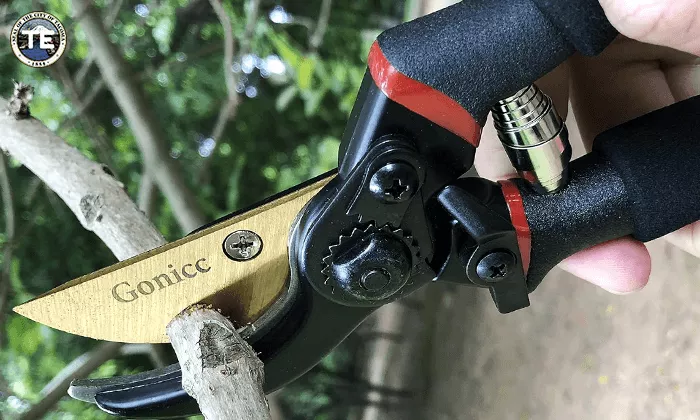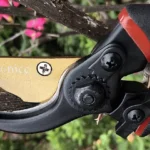Spring heralds a season of renewal and growth, making it a cherished time for gardeners. As the frost recedes and the first green shoots emerge, the garden becomes a canvas of potential. This period of awakening not only invites a resurgence of color and life but also beckons gardeners to begin the rewarding task of planting, pruning, and nurturing. Bypass shears are a must-have for any gardener.
Bypass shears often likened to scissors for plants, are an essential tool in the gardener's kit, known for their precision and clean cuts. These tools have evolved from rudimentary cutting instruments to sophisticated pruning devices, essential for maintaining healthy plants and gardens. This guide delves into the world of bypass shears, exploring their mechanics, types, and best practices for use in gardening and horticulture.
How Bypass Shears Work
At the heart of bypass shears is a simple yet effective mechanism: a curved, sharp blade that sweeps past a broad, flatter blade, delivering a clean and close cut similar to scissors. This design contrasts with anvil shears, where a single blade presses against a flat surface. Bypass shears are preferred for precise cuts that promote plant health, reducing damage and disease risk. They are typically made from high-carbon steel or other durable materials, ensuring longevity and sharpness.
Types of Bypass Shears
Bypass shears come in various forms, each suited to different tasks:
- Handheld Bypass Pruners: Ideal for cutting thin branches, flowers, and vines, these are the most common type, designed for ease of use and precision.
- Loppers: With long handles and larger blades, loppers are perfect for thicker branches, allowing for leverage and extended reach without compromising on accuracy.
- Pole Pruners: These are designed for height, enabling the pruning of branches up high without the need for ladders, thanks to extendable handles.
Each type is tailored to specific gardening needs, from detailed shaping to managing tall trees and dense shrubs.
Features of High-Quality Bypass Shears
Investing in high-quality bypass shears can significantly affect your gardening experience. Key features to look for include:
- Blade Material: Stainless steel or carbon steel blades remain sharp and resist rust.
- Handle Design: Ergonomic handles reduce hand fatigue and increase comfort, important for frequent use.
- Durability: Well-constructed shears withstand regular use, with replaceable parts ensuring long-term utility.
- Safety Features: Locking mechanisms and non-slip grips enhance safety and control.
Understanding these features helps in selecting shears that are not only effective but also a pleasure to use.
Using Bypass Shears
Using bypass shears effectively requires understanding the right techniques and maintenance practices. Here’s how to make the most of these essential gardening tools:
- Proper Cutting Technique: Always cut at an angle, about 45 degrees, just above a bud or branch to encourage healthy growth. Ensure the cutting blade faces the plant's main body to produce a cleaner cut.
- Maintenance: Regularly clean the blades with a mild disinfectant to prevent disease spread. Sharpen the blades as needed to keep them cutting smoothly and efficiently.
- Care: After each use, wipe the shears clean and oil the pivot point to prevent rust and ensure smooth operation.
Benefits of Using Bypass Shears

Bypass shears offer several advantages that make them a favorite among gardeners:
- Precision Cuts: The design allows for accurate, clean cuts, minimizing plant stress and promoting faster healing.
- Versatility: Suitable for a wide range of plants, from delicate flowers to sturdy branches, bypass shears can handle diverse pruning tasks.
- Ease of Use: With features like ergonomic handles and lightweight construction, they reduce fatigue, making gardening more enjoyable.
Selecting the Right Bypass Shears
Choosing the right bypass shears depends on your specific gardening needs:
- Consider the Size and Type of Plants: Larger shears are better for thick branches, while smaller ones are ideal for delicate pruning.
- User Comfort: Look for shears with handles that fit comfortably in your hand, especially if you have arthritis or other hand mobility issues.
- Budget: Invest in the best quality you can afford, as higher-quality shears will last longer and perform better.
Advanced Tips and Tricks
To elevate your pruning skills, consider the following advanced tips:
- Regular Sharpening: Keep your shears sharp for clean cuts; a dull blade can damage plants and make pruning more difficult.
- Pruning Technique: Learn the specific pruning needs of each plant in your garden to encourage healthy growth and flowering.
- Professional Care: Periodically have your shears professionally serviced to maintain optimal performance.
Bypass shears are indispensable for gardeners seeking precision and efficiency in their pruning tasks. Understanding the nuances of their operation, care, and the benefits they offer can transform your gardening practice. Investing in the right pair of bypass shears is an investment in the health and beauty of your garden.

Carl Riedel is an experienced writer and Open Source Intelligence (OSINT) specialist, known for insightful articles that illuminate underreported issues. Passionate about free speech, he expertly transforms public data into compelling narratives, influencing public discourse.














